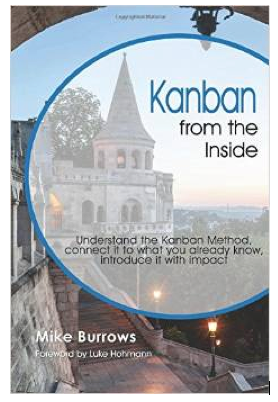This series of short excerpts from my book, Kanban from the Inside has reached Part II (Models). For the next few chapters we look outside to other important bodies of knowledge.
I’m not going to reproduce here chapter 11’s tour through Systems Thinking and related fields—I’ll jump straight to some of my conclusions. If they leave you hungry for the detail, you’ll have to read the book!
The Method’s Design
Several elements of the Kanban Method have their roots in the models outlined in this chapter. In particular:
- The transparency practices (Chapter 1) create new leverage points, making the system more open to challenge and improvement. Furthermore, they can promote self-organization, a strategy for resilience in the presence of uncertainty.
- Core practice 5, Improve collaboratively, evolve experimentally, connectscollaboration (Chapter 3), knowledge, experimentation, shared learning, and evolutionary change.
- Kanban shares with Lean (Chapter 13) a Systems Thinking approach to leadership(Chapter 6). In the long run, organizations get the leadership they deserve, the kind that their system recruits, encourages, and promotes. It follows that the most enduring organizations are those that have paid attention to this.
- Albeit implicitly, the first foundational principle, start with what you do now, points both to Systems Thinking and to evolutionary change. I’ve added some extra emphasis by abstracting from this principle the understanding value (Chapter 7)—the goal is for organizations to value understanding and to have the discipline to make it the precursor to change.
- Evolutionary change is explicit in the second foundational principle, agree to pursue incremental, evolutionary change (see Chapter 8, agreement).
Earlier chapters have made it clear that the Kanban Method leaves room for interpretation. This is a strength. It is articulated sufficiently clearly for a community to rally around it, yet it is applied with sufficient diversity that its community continues to learn, to develop lower-level practices, and to share experiences. It is satisfying to observe that the Kanban community itself demonstrates in some measure all five of Senge’s characteristics of the Learning Organization.
Application
Neither Kanban nor Systems Thinking should be one-off exercises or specialist, “ivory tower” disciplines that are kept separate from where the “real work” is done. John Gall advises this (sometimes known as Gall’s law):
A complex system that works is invariably found to have evolved from a simple system that worked. The inverse proposition also appears to be true: A complex system designed from scratch never works and cannot be made to work. You have to start over, beginning with a working simple system[1].
Don’t worry that every step must be right first time. Keeping the system in motion withsafe-to-fail experiments, there’s a limit to how much harm any one step can do, and any local difficulties will soon shake out. Under these conditions, suboptimization—the localized improvement that makes things worse globally—is less a problem than the loss of momentum caused by fear of it. “The perfect is the enemy of the good,” as they say.


